
Understanding the coarse and fine adjustment knobs on a microscope
On the side of almost every microscope, no matter how cheap or expensive, you’ll find the focus adjustment knobs.
Unassuming yet essential, these little black dials determine whether you see a crystal-clear image or a blur.
Here’s a quick overview of the coarse and fine adjustment knobs, and how they work.
Where to find the coarse and fine adjustment knobs
The focus adjustment knobs are mostly found in the same place on microscopes, but there can be a few differences depending on the model.
Typically, they are located on either side of the neck of the microscope, just above the base.
On modern microscopes, the fine and coarse knobs tend to be arranged together for ease of access, one on top of the other. To adjust the coarse focus, you turn the outer section; to adjust the fine focus, you turn the inner section.
Other models may have separate fine and coarse knobs located next to each other. Occasionally, the knobs may only be on one side of the microscope, which can be an issue for left-handers.
What do they do?
While vital, these knobs perform one disarmingly simple task. Turning the knobs simply raises or lowers the stage (platform) on which your slides and samples sit.
The coarse focus knob provides larger, more rapid movement, while the fine adjustment knob offers much finer control.
Having both coarse and fine control allows you to easily bring your samples and specimens into focus at any level of magnification with a minimum of fuss.
How do they work?
Microscopes are generally focused on a minuscule area. This focal point is a product of the microscope’s optical system and can’t be readily changed.
When you adjust the ‘focus’ on a microscope, you aren’t actually moving the objective lenses; you’re moving your sample up and down through that area of focus until you get a clear image.
How to use the focus knobs
The focus knobs are easy to use, but there are a few things to know.
Operating them is straightforward – turn the knob one way to raise the microscope stage, and the other way to lower it.
The most important thing to know is when to use each knob, because there can be unfortunate consequences if you get this wrong.
The coarse control knob is used with lower magnification objective lenses, such as 4x or 10x. It’s also used to lower the stage for easier access.
At higher magnifications though, the coarse control is too much. When using the 40x or 100x objectives, the distance between the objective lens and the sample slide is far too small. Turning the coarse control at higher magnifications can easily crash the slide into the lens, cracking your slide and scratching the lens.
In short, at higher magnifications only the fine control knob should be used.
Aside from potentially damaging your microscope, by the time you switch to higher magnifications, the sample should already be almost in focus, so you should only need very small adjustments provided by the fine control to bring the slightly blurry image into clear focus.
